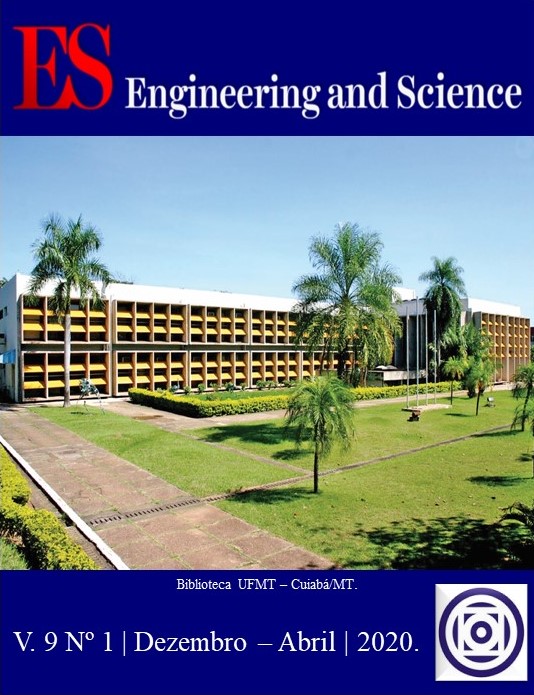Numerical Study Via Finite Element Analysis of the Structural Behavior of Rigid Pavement of Aerodromes
DOI:
10.18607/ES202099827Palavras-chave:
Concrete airfield pavement. Three-dimensional finite element analysis. Dowel bars. Transverse joint.Resumo
The present study develops a 3D numerical model of the concrete pavement system of aerodromes in contact with the main landing gear of aircrafts using Finite Element Method (FEM). The pavement system used in the analysis consisted of six concrete slabs overlaying a subgrade medium with stiffness k. Doweled bars are considered for the pavement transverse joints while aggregate interlocks are considered for longitudinal joints. A parametric study was conducted to validate the model numerically, as well as to investigate the influence of the doweled bars, aggregate interlocks and subgrade stiffness on the pavement deflections when it is subjected to a dynamic load. About 77% decrease in deflection was attained due to the presence of doweled bars. This study additionally presents a methodology for designing the pavement thickness and the compressive strength of concrete based upon the Mohr-Coulomb’s failure criterion. It is found that for a pavement thickness of 0.305m the minimum compressive strength of concrete should be 28 MPa.
##plugins.generic.paperbuzz.metrics##
Referências
ABNT - ASSOCIAÇÃO BRASILEIRA DE NORMAS TÉCNICAS. NBR 6118. Projeto de estruturas de concreto – Procedimento. RJ, Associação Brasileira de Normas Técnicas, 2014.
ALVAPPILLAI, A.; ZAMAN, M.; LAGUROS, J. Finite element algorithm for joited concrete pavements subjected to moving aircraft. Computers and Geotechnics, v.14, n. 3, p. 121-147, 1992. doi.org/10.1016/0266-352X(92)90030-W
ANSYS. ANSYS Help: Mechanical APDL Documentation. 2018.
BALBO, J. T. Pavimentos de concreto. 1st ed. São Paulo: Ed. Oficina de Textos, 2009.
BEER, F.; JOHNSTON Jr., E. R.; DEWOLF, J.; MAZUREK, D. Mechanics of Materials. 7th Ed., New York: McGraw-Hill Education, 2015.
BUDYNAS, R. G.; NISBETT, J. K. Shigley's Mechanical Engineering Design. 10th Ed., New York: McGraw-Hill Education, 2015.
CALIENDO, C.; PARISI, A. Stress-Prediction Model for Airport Pavements with Jointed Concrete Slabs. Journal of Transportation Engineering, v. 136, n. 7, p. 664-677, 2010. doi: 10.1061/(ASCE)TE.1943-5436.0000151
DELATTE, N. Concrete Pavement Design, Construction and Performance. 1st ed. New York: Ed. Taylor&Francis, 2008.
KANDEKAR, S. B.; TALIKOTI, R. S. Torsional behaviour of reinforced concrete beam wrapped with aramidfiber. Journal of King Saud University:Engineering Sciences, v. 3, n. 4, p. 340-344, 2019. doi: 10.1016/j.jksues.2018.02.001
KIM S. H.; PARK J. Y.; JEONG J. H. Effect of temperature-induced load on airport concrete pavement behavior. KSCE Journal of Civil Engineering, v.18, n.1, p.182-187, 2014. doi: 10.1007/s12205-014-0056-7
KIM, J.; HJELMSTAD, K. D. Three- Dimensional Finite Element Analysis of Doweled Joints for Airport Pavements. Annual Meeting of Transportation Research Board. Washington, D.C. Publication in Transportation Research Record, 2003. doi: 10.3141/1853-12
MAHMOUD, A. M. Finite element implementation of punching shear behaviors in shear-reinforced flat slabs. Ain Shams Engineering Journal, v. 6, p. 735-754, 2015. doi: 10.1016/j.asej.2014.12.015
PRAWESTI, P.; SUHENDRO, B.; HAPSORO, S. Evaluation of rigid pavement on apron of terminal 3 Soekarno-Hatta International Airport using finite element method. MATEC Web of Conferences, v. 270, 2019. doi: 10.1051/matecconf/201927003005
RODCHENKO, O. Computer Technologies for Concrete Airfield Pavement Design. Journal Aviation, v. 21, n. 3, p. 111-117, 2017. doi: 10.3846/16487788.2017.1379439
SILVA, S. C.; BANDEIRA, A. A. Analyses of reinforced concrete beams strengthened with CFRP under bending: theorical and computational approaches. Revista Ibracon de Estruturas & Materiais, v. 12, n. 2, p. 233-254, 2019. doi: 10.1590/s1983-41952019000200003
YAN-CONG, Z.; LING-LING, G. Effect of dowel bar position deviation on joint load-transfer ability of cement concrete pavement. International Journal of Pavement Research and Technology, v. 9, n. 1, p. 30-36, 2016. doi: 10.1016/j.ijprt.2016.01.002
Downloads
Publicado
Como Citar
Edição
Seção
Licença
Todos os direitos autorais devem ser cedidos a Universidade Federal de Mato Grosso.
























